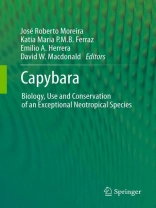The capybara is the neotropical mammal with the highest potential for production and domestication. Amongst the favorable characteristics for domestication we can list its high prolificacy, rapid growth rate, a herbivorous diet, social behavior and relative tameness. The genus (with only two species) is found from the Panama Canal to the north of Argentina on the east of the Andes. Chile is the only country in South America where the capybara is not found. The species is eaten all over its range, especially by poor, rural and traditional communities engaged in subsistence hunting. On the other hand, in large urban settlements wildlife is consumed by city dwellers as a delicacy. The sustainable management of capybara in the wild has been adopted by some South American countries, while others have encouraged capybara rearing in captivity.
विषयसूची
Foreword.- Preface.- Part I: Biology, Ecology and Evolution.- Taxonomy, natural history and distribution of the capybara.- Paleontology, evolution and systematics of capybara.- Phylogenetics of Caviomorph rodents and genetic perspectives on the evolution of sociality and mating systems in the Caviidae.- Foraging strategies and feeding habits of capybaras.- Capybara digestive adaptations.- Reproductive morphology and physiology of the male capybara.- Morphology and reproductive physiology of female capybaras.- Capybara demographic traits.- Diseases of capybara.- Capybara scent glands and scent-marking behavior.- Capybara social behavior and use of space: patterns and processes.- Part II: Production.- Products and uses of capybaras.- Confined and semi-confined production systems for capybaras.- Social and spatial relationships of capybaras in a semi-confined production system.- Feeds and nutrition of farmed capybaras.- The impact of management practices on female capybara reproductive parameters in captivity.- The sustainable management of capybaras.- Part III: Conservation.- Capybaras as a source of protein: utilization and management in Venezuela.- Conservation and use of the capybara and the lesser capybara in Colombia.- Capybara production in Brazil: captive breeding or sustainable management?.- Capybaras use in Argentina.- Counting capybaras.- Brazilian spotted fever: the role of capybaras.- The capybara paradigm: from sociality to sustainability.- Index.












